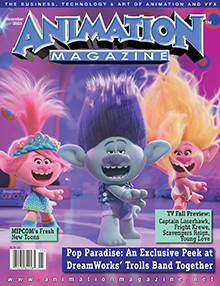|
Getting your Trinity Audio player ready...
|
In Rita Basulto’s powerful

stop-motion short Humo (Smoke), a young boy hides in the sewers to avoid a sinister destination known as the smokehouse. The Holocaust-themed project was nominated for a Cristal at Annecy and won the Oscar-qualifying Best Animated Short prize at the Hollyshorts festival in Los Angeles this past August. The Guadalajara-born director, whose previous shorts Lluvia en los ojos (2013) and Zimbo (2015) also received much praise on the festival circuit, discussed her new project with us in a recent email exchange.
“Humo is based on a children’s book written by Antón Fortes and beautifully illustrated by Joanna Concejo for the Spanish publishing house OQO,” says Basulto. “It’s a powerful story that immediately caught my attention, so I wanted to depict it in stop-motion. Previously we had made other short films inspired by books from the same publisher, co-produced by OUTIK, our studio. These short films were being made year after year; making Humo was simply a matter of time.”
The talented director, who is a member of Gudalajara’s Taller del Chucho and painted the black rabbits on Guillermo del Toro’s Pinocchio, says she tried to stay true to the aesthetic of the book’s illustrations while adding some of her own artistic views as well. “I wanted it to look very organic, sometimes even theatrical and handmade,” she explains. “I was inspired by the engravings of German artist Käthe Schmidt Kollwitz, which I discovered many years ago as a student of fine arts. It seemed very natural to me to solve the aesthetics of the film with classic charcoal and watercolor techniques.”

I WANTED IT TO LOOK VERY ORGANIC, SOMETIMES EVEN THEATRICAL AND HANDMADE.IT SEEMED VERY NATURAL TO ME TO SOLVE THE AESTHETICS OF THE FILM WITH CLASSIC CHARCOAL AND WATERCOLOR TECHNIQUES.’
— DIRECTOR RITA BASULTO
Basulto, who counts animation luminaries such as Jan Švankmajer, Alexander Petrov, Hayao Miyazaki and Theodore Ushev as her idols, points out that a short film like Humo would usually take a year and a half to finish under normal circumstances. “However, it took me six years to complete this short, because in the meantime I got invited to work on projects I couldn’t refuse, like Guillermo del Toro’s Pinocchio. In addition, we had to stop working when the pandemic arose. I had a very talented crew working with me; some people worked for short periods, but the main crew was about 15 people.
Remarkably, all of the film’s meticulous, hand-crafted animation was done in Basulto’s home studio. She notes, “Because of the visual nature and technical solutions I worked in to tell the story, I didn’t need too much space. We pretty much animated the whole short in a small room.”

Humo’s main puppets were made with resin, aluminum wire, steel joints and paper. The secondary characters were made using a cutout technique on di”erent kinds of paper. Basulto’s methodology in choosing some of the various techniques was directly influenced by pictures of concentration camps and her style as an artist.
When asked about the toughest aspect of finishing her labor of love, Basulto responds, “As a single mother, the biggest challenge was to find how to balance working on this project and raising my son.” She adds, “I am very proud of how I managed to finish the short film with limited resources without sacrificing the visual looks and narrative I was looking for.”
Follow updates on Humo through OUTIK Animation on Facebook or Rita Basulto’s own Facebook, Instagram and Twitter/X.










 Win 'The Art of DreamWorks Dog Man'!
Win 'The Art of DreamWorks Dog Man'! 

